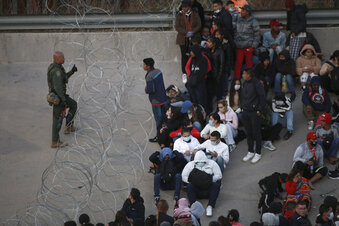Migrants at US-Mexico border await ruling on asylum limits
5 min read
U.S. military prevent migrants from crossing into El Paso, Texas, as seen from Ciudad Juarez, Mexico, Tuesday, Dec. 20, 2022. Tensions remained high at the U.S-Mexico border Tuesday amid uncertainty over the future of restrictions on asylum-seekers, with the Biden administration asking the Supreme Court not to lift the limits before Christmas. (AP Photo/Christian Chavez)
EL PASO, Texas (AP) — Migrants along the U.S. border with Mexico sought shelter from the cold early Wednesday as they waited for the Supreme Court to rule on whether and when restrictions that prevented many from seeking asylum in the U.S. would lift.
Pandemic-era limits on border crossings had been set to expire Wednesday — and the federal government opposed an effort by some conservative-leaning states to keep them in place. But hours before they were about to end, the Biden administration asked the court not to remove them before Christmas.
It’s not clear when the court’s decision will come. Meantime, thousands of people have gathered all along the Mexican side of the southern border, camping outside or packing into shelters, hoping for the opportunity to seek refuge in the U.S. The Texas National Guard took up positions in El Paso.
Jhorman Morey, a 38-year-old mechanic from Venezuela, warmed his hands by a campfire with a half-dozen other migrants on the southern side of the Rio Grande. He said he was waiting for a decision on the restrictions before attempting to cross into the U.S., though other migrants waded through shallow waters toward a gate in the border fence.
“I want them to decide” on the public health rule known as Title 42, said Morey, who arrived in the Mexican city of Juarez, across the border from El Paso, six weeks ago. He now rarely eats after exhausting his savings.
Hundreds of migrants remained in line in Juarez. Others slept along the concrete embankments of the Rio Grande. A nearby shelter reached its capacity Tuesday night, stranding many outside.
As crowds gathered on the banks of Rio Grande, 1st Sgt. Suzanne Ringle said one woman went into labor and was assisted by Border Patrol agents. She added many children were among the crowd.
In Tijuana, which has an estimated 5,000 migrants staying in more than 30 shelters and many more renting rooms and apartments, the border was quiet Tuesday night as word spread among would-be asylum-seekers that nothing had changed. Layered, razor-topped walls rising 30 feet (9 meters) along the border with San Diego make the area daunting for illegal crossings.
Under the restrictions, officials have expelled asylum-seekers inside the United States 2.5 million times, and turned away most people who requested asylum at the border, on grounds of preventing the spread of COVID-19 under Title 42.
Immigration advocates have said that the restrictions go against American and international obligations to people fleeing to the U.S. to escape persecution, and that the pretext is outdated as coronavirus treatments improve. They sued to end the use of Title 42; a federal judge sided with them in November and set the Dec. 21 deadline.
Conservative-leaning states appealed to the Supreme Court, warning that an increase in migration would take a toll on public services and cause an “unprecedented calamity” that they said the federal government had no plan to deal with.
In response, Chief Justice John Roberts issued a temporary order to keep the restrictions in place.
While the federal government then asked the Supreme Court to reject the states’ effort on Tuesday, it also acknowledged that ending the restrictions abruptly will likely lead to “disruption and a temporary increase in unlawful border crossings.”
States filed a response early Wednesday, arguing the Supreme Court should keep the asylum restrictions in place while it reviews the lower court decision because letting them expire would cause “immediate, severe, and irreversible harms” to the states. They said even federal officials acknowledge an impending border crisis, and argued that the reasons Title 42 was used during the pandemic could “easily recur.”
Though the Wednesday expiration date had been set weeks ago, the U.S. government asked for more time to prepare — while saying that it has sent more resources to the border and maintaining that the solution is not to extend the rule indefinitely.
About 23,000 agents are currently deployed to the southern border, according to the White House. The Biden administration said it has sent more Border Patrol processing coordinators, more surveillance and increased security at ports of entry.
Should the Supreme Court act before Friday, the government wants the restrictions in place until the end of Dec. 27. If the court acts on Friday or later, the government wants the limits to remain until the second business day following such an order.
As the decision went down to the wire, pressure built in communities along both sides of the U.S-Mexico border.
In El Paso, Democratic Mayor Oscar Leeser warned that shelters across the border in Juarez were packed to capacity, with an estimated 20,000 migrants prepared to cross into the U.S.
The city has rushed to expand its ability to accommodate more migrants by converting large buildings into shelters, as the Red Cross brings in 10,000 cots.
“We will continue to be prepared for whatever is coming through,” Leeser said.
Texas National Guard members, deployed by the state to El Paso this week, used razor wire to cordon off a gap in the border fence along a bank of the Rio Grande that became a popular crossing point for migrants who waded through shallow waters to approach immigration officials in recent days. They used a loudspeaker to announce in Spanish that it’s illegal to cross there.
Texas said it was sending 400 National Guard personnel to the border city after local officials declared a state of emergency. Leeser said the declaration was aimed largely at protecting vulnerable migrants, while a statement from the Texas National Guard said the deployment included forces used to “repel and turn-back illegal immigrants.”
In San Diego, a sense of normalcy returned to the nation’s busiest border crossing despite uncertainty in recent days. The San Ysidro Chamber of Commerce said it learned from U.S. Customs and Border Protection that the more modern, western half of the airport-sized pedestrian crossing would reopen to U.S.-bound travelers Wednesday at 6 a.m. The lanes, which lead to an upscale outlet mall, have been closed to almost all migrants since early 2020 to accommodate Title 42 processing.
The reopening comes “just in time for last-minute shoppers, visiting family members and those working during the holidays,” the chamber wrote to members. It said it didn’t know when the area would reopen to travelers going to Mexico from the United States.
At a church-affiliated shelter in El Paso a few blocks from the border, the Rev. Michael Gallagher said local faith leaders have been trying to pool resources and open up empty space. On Tuesday, a gym at Sacred Heart Church gave shelter to 200 migrants — mostly women and children. Outside the church early Wednesday, dozens of people slept on the street.
Title 42 allows the government to expel asylum-seekers of all nationalities, but it’s disproportionately affected people from countries whose citizens Mexico has agreed to take: Guatemala, Honduras, El Salvador and, more recently, Venezuela, in addition to Mexico.






